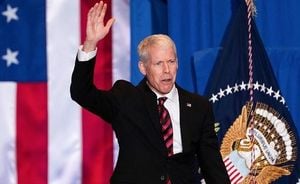In early February 1886, the streets of Seattle bore witness to a violent episode that would echo through generations: a mob, led by a local labor union and spurred on by the national wave of anti-Chinese sentiment, forcibly expelled around 350 Chinese immigrants from their homes. Known as the Anti-Chinese Riot or Seattle Riot, this event was part of a broader pattern of discrimination and exclusion that targeted Chinese communities along the West Coast in the late nineteenth century. Now, nearly 140 years later, the city is taking steps to confront this difficult chapter in its history by supporting a new public memorial—a 14-foot-tall statue designed to honor those who suffered during the riot and to spark important conversations about race, belonging, and justice.
The Wing Luke Museum, located in Seattle’s Chinatown-International District, has spearheaded efforts to create the memorial. They selected a design by Seattle artist Stewart Wong, whose vision for the statue is both striking and deeply symbolic. The monument takes the form of an X-like structure, with three human figures on either side. These figures are meant to represent the divide between the city’s white workers and the Chinese immigrants who, at the time, provided much of the labor in mines, canneries, and on the railroads. Rifles and imbalanced scales of justice are incorporated into the sculpture, underscoring the violence and inequity that shaped the events of 1886.
“The biggest challenge for me is to create an impactful art installation, considering the importance of this historical event that still resonates with what is happening politically today,” Wong said, as quoted by the Associated Press. His hope is that the statue will not only memorialize the past but also prompt viewers to reflect on ongoing issues of discrimination and exclusion faced by immigrant communities in the United States.
The riot itself was the culmination of years of mounting hostility toward Chinese immigrants. According to reporting by the Associated Press, white laborers along the West Coast, feeling threatened by what they saw as unfair economic competition from low-paid Chinese workers, organized efforts to expel them. This sentiment was codified in the Chinese Exclusion Act of 1882, which banned Chinese laborers from immigrating to the U.S. and prevented those already in the country from becoming citizens. In Seattle, the situation boiled over on February 7, 1886, when a mob led by the Knights of Labor forcibly removed Chinese residents from their homes. Most were put aboard a ship and sent away; a riot ensued when a judge ordered that the remaining immigrants be escorted back to their homes to await a second ship. At least one person—a member of the mob—lost their life in the chaos.
The statue will be installed near the ferry terminal on Alaskan Way, the very spot where Chinese immigrants were forced to board ships and leave the city. This location, just steps from Seattle’s bustling waterfront, was chosen to ensure that the memorial is both visible and accessible—a daily reminder to locals and visitors alike of the city’s complex history.
Funding for the project has come from a variety of sources, including a recent $50,000 donation from the Seattle FIFA World Cup 26 committee. This contribution, as reported by the Associated Press, means that the Wing Luke Museum is now over halfway to its fundraising goal. At a ceremony celebrating the donation, Diane Sugimura, vice president of the museum’s board of trustees, remarked, “This is an amazing show of support for untold stories of the immigrants—what they endured from colonialism, racism, segregation, expulsion—right here at our front door.” She gestured toward the city’s waterfront, underscoring the importance of reclaiming and sharing these stories.
Outgoing Seattle Mayor Bruce Harrell also spoke at the event, reflecting on the significance of the project. “That is who we are. That is our DNA. We don’t run from it,” Harrell said. “In fact, we want others to know how we got to where we are because of our resilience, our faith, our belief in one another.”
The Chinese American Legacy Artwork Project, as the statue initiative is officially known, has been more than two decades in the making. Dough Chin, a historian and former president of OCA Asian Pacific American Advocates of Greater Seattle, led the early efforts to bring the memorial to life. Over the years, the Wing Luke Museum established a governing committee to help guide the project, ensuring that it reflects the voices and experiences of Seattle’s Chinese American community. However, the museum has made it clear that the statue will not be completed in time for the 2026 FIFA World Cup, despite the recent boost in funding.
The story of the Anti-Chinese Riot and its aftermath resonates far beyond Seattle. Across the United States, Chinese American communities have grappled with the legacy of exclusion, discrimination, and violence. In places like Los Angeles’ San Gabriel Valley, which is now home to more than half a million Asian Americans, many of whom are Chinese, the scars of history are still felt. As Camille Tai, a columnist for The Michigan Daily, wrote, “We learned about the Chinese Exclusion Act in class and saw ‘dog eater’ jokes on online platforms, but these issues often seemed far removed from our community.” For many second-generation Chinese Americans, growing up in ethnically concentrated suburbs—so-called “ethnoburbs”—provided a sense of safety and cultural pride that was not always available to earlier generations.
Yet, as Tai and others have observed, this sense of security can be fragile. The COVID-19 pandemic, for example, brought a wave of anti-Asian hate crimes and renewed public awareness of systemic racism. “All of a sudden, there were news broadcasts about hate crimes, ‘Stop Asian Hate’ posters on walls and a mural at Westfield Santa Anita honoring Chinese American history,” Tai recalled. Even in areas with large Asian populations, incidents of verbal and physical attacks were reported, shattering the illusion of immunity from discrimination.
For those who leave these cultural enclaves, the contrast can be stark. Tai described her move from the San Gabriel Valley, where Asians made up nearly 70% of the population, to the University of Michigan in Ann Arbor, where that figure dropped to about 20%. “For the first time, I found myself physically searching for other Asian students, wondering whether they shared my sentiments,” she wrote. Encounters with racism and ignorance on campus forced her to confront the realities of being a minority in America—realities that many Chinese immigrants in Seattle faced in 1886, and that their descendants continue to navigate today.
The forthcoming statue near Seattle’s waterfront is more than just a memorial; it is a call to remember, to educate, and to reckon with the past. As Stewart Wong’s design suggests, the divide between communities is not just a relic of history—it is a challenge that persists, demanding both acknowledgment and action. The hope is that, by shining a light on stories too long ignored, Seattle can help foster a more just and inclusive future.
As the city looks ahead to the 2026 FIFA World Cup and beyond, the statue will stand as a testament to the resilience of those who endured—and a reminder to all that the work of building community is never truly finished.




